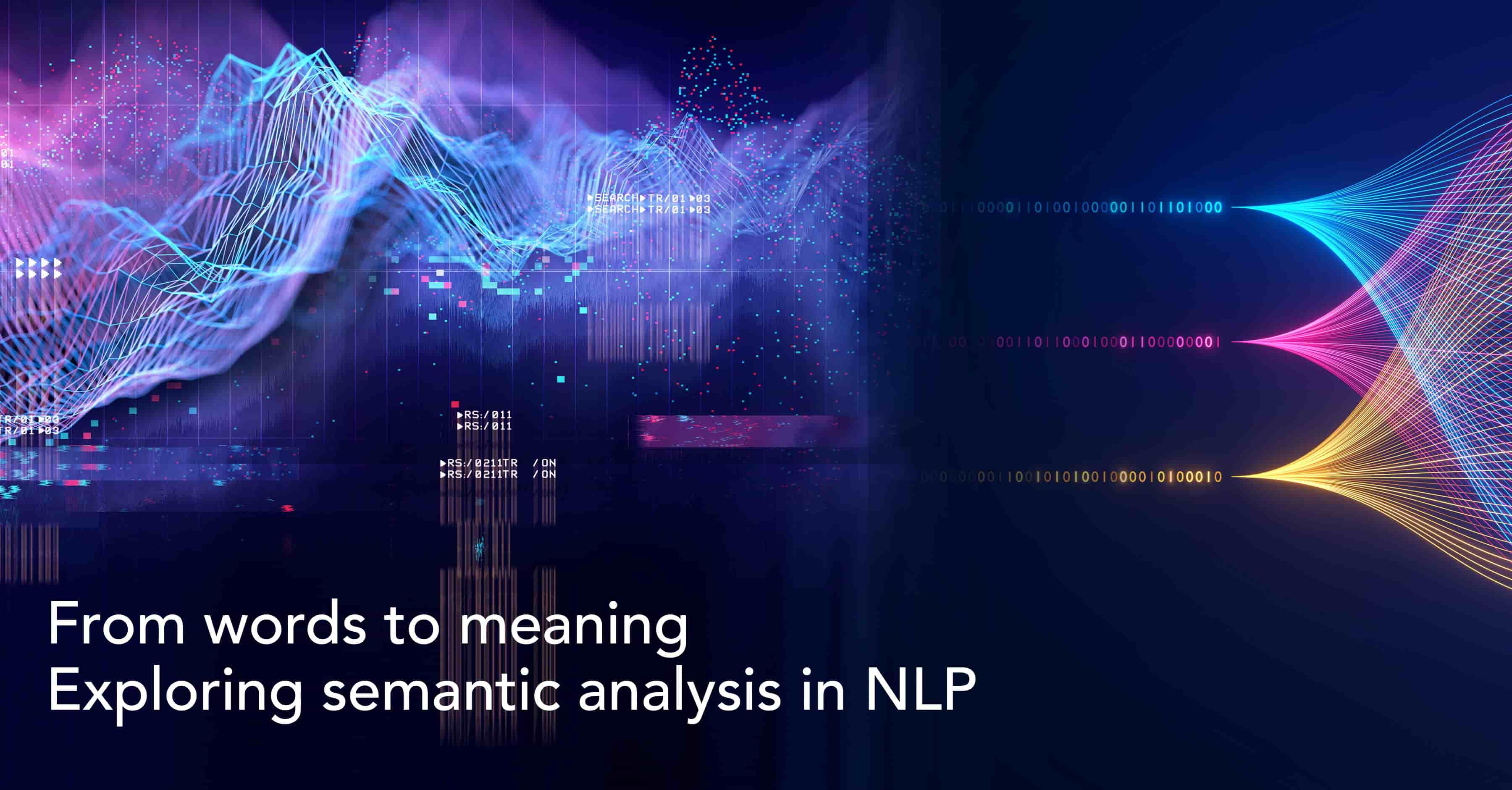From words to meaning: Exploring semantic analysis in NLP

Audio version
There’s more biomedical data than ever, but making sense of it is still tough. In this blog, we look at how semantic analysis—an essential part of natural language processing (NLP)—helps researchers turn free text into structured insights. From identifying key biomedical terms to mapping relationships between them, we explore how these techniques support everything from literature mining to optimizing clinical trials.
What is semantic analysis in linguistics?
Semantic analysis is an important subfield of linguistics, the systematic scientific investigation of the properties and characteristics of natural human language. As the study of the meaning of words and sentences, semantics analysis complements other linguistic subbranches that study phonetics (the study of sounds), morphology (the study of word units), syntax (the study of how words form sentences), and pragmatics (the study of how context impacts meaning), to name just a few.
There are three broad subcategories of semantics:
- Formal semantics: The study of the meaning of linguistic expressions using mathematical-logical formalizations, such as first-order predicate logic or lambda calculus, to natural languages.
- Conceptual semantics: This is the study of words, phrases, and sentences based not just on a set of strict semantic criteria but on schematic and prototypical structures in the minds of language users.
- Lexical semantics: The study of word meanings not just in terms of the basic meaning of a lexical unit but in terms of the semantic relations that integrate these units into a broader linguistic system.
Semantic analysis in Natural Language Processing (NLP)
In NLP, semantic analysis is the process of automatically extracting meaning from natural languages in order to enable human-like comprehension in machines. There are two broad methods for using semantic analysis to comprehend meaning in natural languages: One, training machine learning models on vast volumes of text to uncover connections, relationships, and patterns that can be used to predict meaning (e.g. ChatGPT). And two, using structured ontologies and databases that pre-define linguistic concepts and relationships that enable semantic analysis algorithms to quickly locate useful information from natural language text.
Though generalized large language model (LLM) based applications are capable of handling broad and common tasks, specialized models based on a domain-specific taxonomy, ontology, and knowledge base design will be essential to power intelligent applications.
How does semantic analysis work?
There are two key components to semantic analysis in NLP. The first is lexical semantics, the study of the meaning of individual words and their relationships. This stage entails obtaining the dictionary definition of the words in the text, parsing each word/element to determine individual functions and properties, and designating a grammatical role for each. Key aspects of lexical semantics include identifying word senses, synonyms, antonyms, hyponyms, hypernyms, and morphology. In the next step, individual words can be combined into a sentence and parsed to establish relationships, understand syntactic structure, and provide meaning.
There are several different approaches within semantic analysis to decode the meaning of a text. Popular approaches include:
- Semantic Feature Analysis (SFA): This approach involves the extraction and representation of shared features across different words in order to highlight word relationships and help determine the importance of individual factors within a text. Key subtasks include feature selection, to highlight attributes associated with each word, feature weighting, to distinguish the importance of different attributes, and feature vectors and similarity measurement, for insights into relationships and similarities between words, phrases, and concepts.
- Latent Semantic Analysis (LSA): This technique extracts meaning by capturing the underlying semantic relationships and context of words in a large corpus. By recognizing the latent associations between words and concepts, LSA enhances machines’ capability to interpret natural languages like humans. The LSA process includes creating a term-document matrix, applying Singular Value Decomposition (SVD) to the matrix, dimension reduction, concept representation, indexing, and retrieval. Probabilistic Latent Semantic Analysis (PLSA) is a variation on LSA with a statistical and probabilistic approach to finding latent relationships.
- Semantic Content Analysis (SCA): This methodology goes beyond simple feature extraction and distribution analysis to consider word usage context and text structure to identify relationships and impute meaning to natural language text. The process broadly involves dependency parsing, to determine grammatical relationships, identifying thematic and case roles to reveal relationships between actions, participants, and objects, and semantic frame identification, for a more refined understanding of contextual associations.
Semantic analysis techniques
Here’s a quick overview of some of the key semantic analysis techniques used in NLP:
Word embeddings
These refer to techniques that represent words as vectors in a continuous vector space and capture semantic relationships based on co-occurrence patterns. Word-to-vector representation techniques are categorized as conventional, or count-based/frequency-based models, distributional, static word embedding models that include latent semantic analysis (LSA), word-to-vector (Word2Vec), global vector (GloVe) and fastText, and contextual models, which include embeddings from large language, generative pre-training, and bidirectional encoder representations from transformers (BERT) models.
Semantic role labeling
This a technique that seeks to answer a central question — who did what to whom, how, when, and where — in many NLP tasks. Semantic Role Labeling identifies the roles that different words play by recognizing the predicate-argument structure of a sentence. It is traditionally broken down into four subtasks: predicate identification, predicate sense disambiguation, argument identification, and argument role labeling. Given Its ability to generate more realistic linguistic representations, semantic role labeling today plays a crucial role in several NLP tasks including question answering, information extraction, and machine translation.
Named entity recognition (NER)
NER is a key information extraction task in NLP for detecting and categorizing named entities, such as names, organizations, locations, events, etc. NER uses machine learning algorithms trained on data sets with predefined entities to automatically analyze and extract entity-related information from new unstructured text. NER methods are classified as rule-based, statistical, machine learning, deep learning, and hybrid models. Biomedical named entity recognition (BioNER) is a foundational step in biomedical NLP systems with a direct impact on critical downstream applications involving biomedical relation extraction, drug-drug interactions, and knowledge base construction. However, the linguistic complexity of biomedical vocabulary makes the detection and prediction of biomedical entities such as diseases, genes, species, chemical, etc. even more challenging than general domain NER. The challenge is often compounded by insufficient sequence labeling, large-scale labeled training data and domain knowledge. Deep learning BioNER methods, such as bidirectional Long Short-Term Memory with a CRF layer (BiLSTM-CRF), Embeddings from Language Models (ELMo), and Bidirectional Encoder Representations from Transformers (BERT), have been successful in addressing several challenges. Currently, there are several variations of the BERT pre-trained language model, including BlueBERT, BioBERT, and PubMedBERT, that have applied to BioNER tasks.
An associated and equally critical task in bioNLP is that of biomedical relation extraction (BioRE), the process of automatically extracting and classifying relationships between complex biomedical entities. In recent years, the integration of attention mechanisms and the availability of pre-trained biomedical language models have helped augment the accuracy and efficiency of BioRE tasks in biomedical applications.
Other semantic analysis techniques involved in extracting meaning and intent from unstructured text include coreference resolution, semantic similarity, semantic parsing, and frame semantics.
The importance of semantic analysis in NLP
Semantic analysis is key to the foundational task of extracting context, intent, and meaning from natural human language and making them machine-readable. This fundamental capability is critical to various NLP applications, from sentiment analysis and information retrieval to machine translation and question-answering systems. The continual refinement of semantic analysis techniques will therefore play a pivotal role in the evolution and advancement of NLP technologies.
How LLMs improve semantic search in biomedical NLP
Semantic search in biomedical literature has evolved far beyond simple keyword matching. Today, large language models (LLMs) enable researchers to retrieve contextually relevant insights from complex, unstructured datasets—such as PubMed—by understanding meaning, not just matching words.
Unlike traditional search, which depends heavily on exact term overlap, LLM-based systems leverage embeddings—dense vector representations of words and phrases—to capture nuanced relationships between biomedical entities. This is especially valuable when mining literature for drug-disease associations, extracting drug-gene relations using NLP, mode-of-action predictions, or identifying multi-sentence relationships between proteins and genes.
By embedding both queries and biomedical documents in the same high-dimensional space, LLMs support more relevant and context-aware retrieval. For instance, a query such as "inhibitors of PD-1 signaling" can retrieve relevant articles even if they don’t explicitly use the phrase "PD-1 inhibitors."
This approach has transformed PubMed mining with NLP by enabling deeper and more intuitive exploration of biomedical text.
LLM-powered semantic search is already being used in PubMed mining tools, clinical trial data extraction, and knowledge graph construction.
Looking ahead: NLP trends in drug discovery
As semantic search continues to evolve, it’s becoming central to biomedical research workflows, enabling faster, deeper insights from unstructured text. The shift from keyword matching to meaning-based retrieval marks a key turning point in NLP-driven drug discovery.
These LLM-powered approaches are especially effective for use cases like:
- Extracting drug-gene interactions
- Identifying biomarkers from literature
- Linking unstructured data across sources
They also help address key challenges in biomedical NLP, such as ambiguity, synonymy, and entity disambiguation across documents.
Subscribe to our Blog and get new articles right after publication into your inbox.
Subscribe to our blog:






